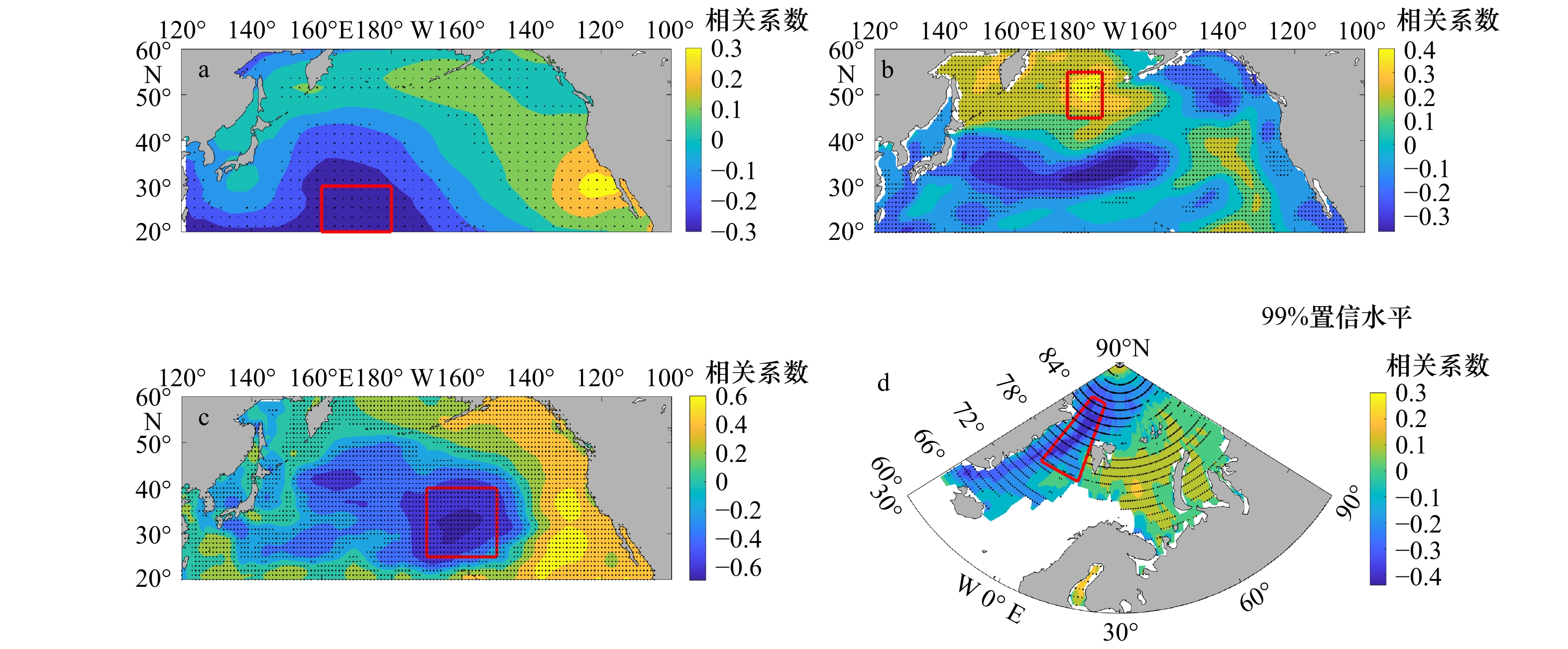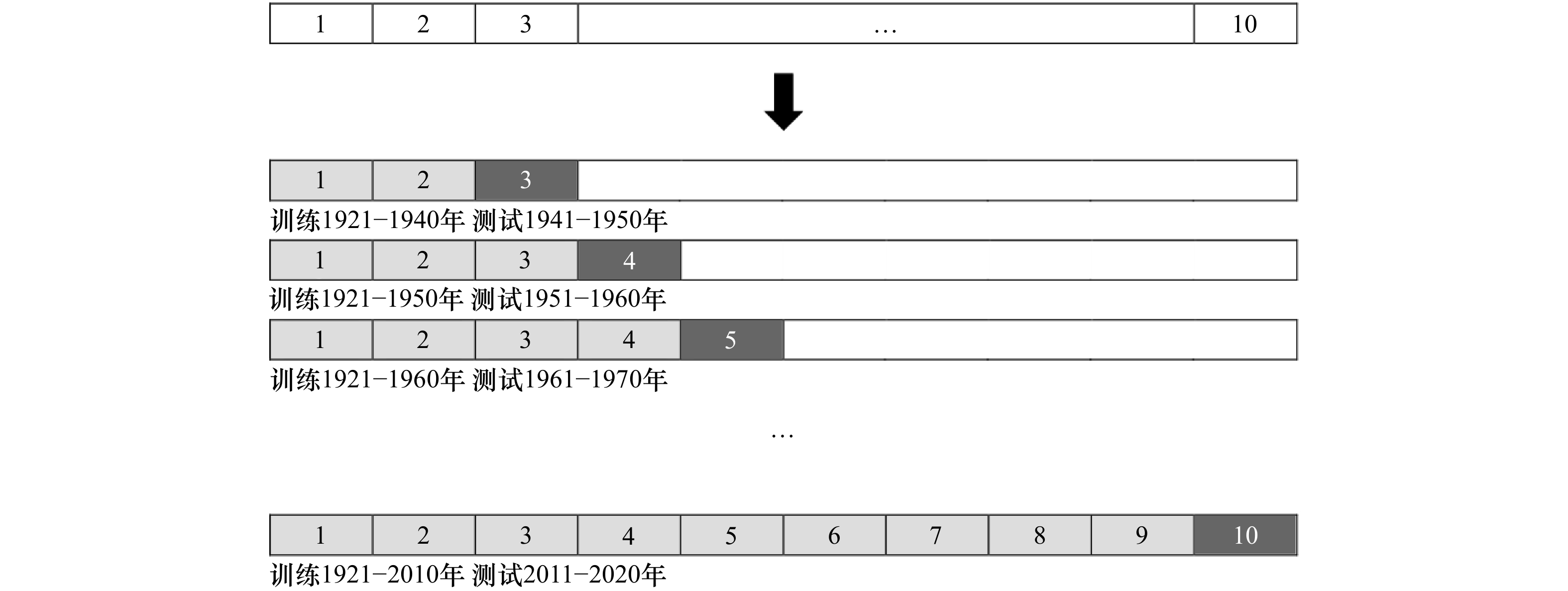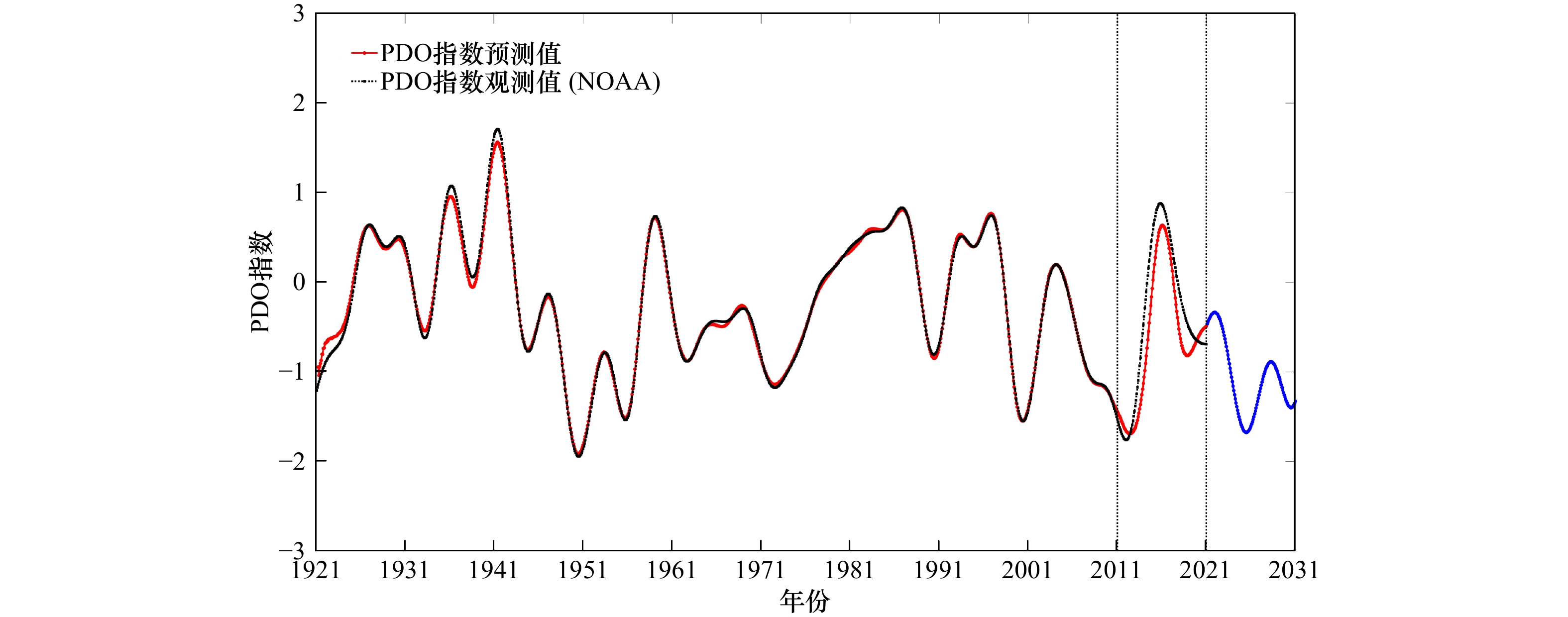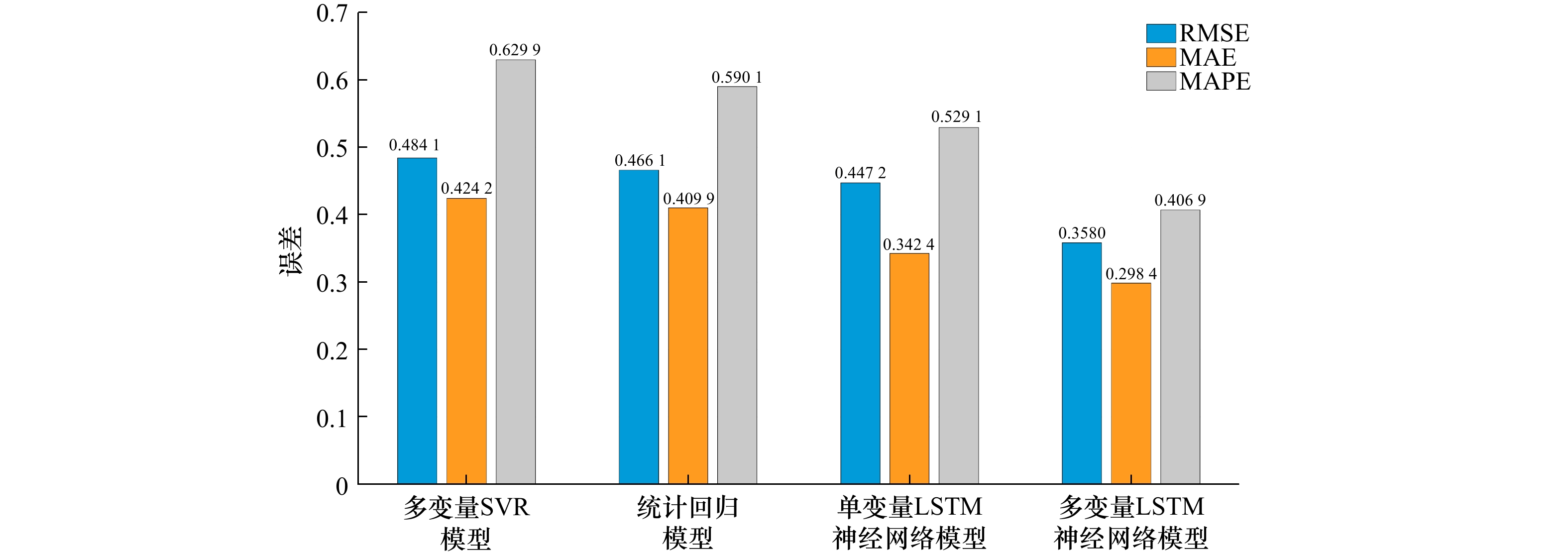Research on PDO index prediction based on multivariate LSTM neural network model
-
摘要: 利用1921–2020年的海平面气压、海平面高度、热含量数据以及海冰密集度作为太平洋年代际振荡(Pacific Decadal Oscillation, PDO)指数的预报要素,建立了关于PDO指数时间序列预测的多变量长短期记忆(Long Short Term Memory, LSTM)神经网络模型,对比分析了2011–2020年不同时间序列预测模型的PDO指数预测结果,最后利用多变量LSTM神经网络模型实现了2021–2030年的PDO指数预测。结果显示,多变量LSTM神经网络模型的预测值与观测值经过交叉验证后的平均相关系数和均方根误差分别为0.70和0.62;PDO未来10年将一直处于冷位相,PDO神经网络指数出现两次波动,于2025年出现最小值。相比于其他时间序列预测模型,本文采用的多变量LSTM神经网络模型预测结果误差小、拟合效果好,可以作为一种新型的预测PDO指数的手段。
-
关键词:
- PDO指数 /
- LSTM神经网络模型 /
- 时间序列预测
Abstract: A multivariate long short term memory (LSTM) neural network model was developed for the Pacific decadal oscillation (PDO) index time series prediction using sea level pressure, sea level height, ocean heat content data and sea ice concentration from 1921 to 2020 as forecast elements of the PDO index. The PDO index prediction results of different time series from 2011 to 2020 were compared and analyzed, and finally the PDO index forecasting from 2021 to 2030 is realized by using the multivariate LSTM neural network model. The results show that the average correlation coefficient and root mean square error of the predicted value and the observed value of the multivariate LSTM model after cross-validation are 0.70 and 0.62, respectively. PDO will remain in the cold phase in the next ten years, and the PDO index will fluctuate twice, there will be a minimum in 2025. Compared with other time series forecasting models, the multivariate LSTM neural network model used in this paper has less error in forecasting results and good fitting effect, which can be used as a new method of predicting PDO index.-
Key words:
- PDO index /
- LSTM neural network model /
- time series forecasting
-
图 3 1921–2020年预报要素与PDO指数的相关系数
a.海平面气压; b. 海平面高度; c. 0~700 m热含量; d. 海冰密集度。其中,红色框为预报因子,加点区域为超过99%的置信水平
Fig. 3 Correlation coefficients of forecast elements and PDO index from 1921 to 2020
a. Sea level pressure; b. sea surface height; c. heat content of the 0−700 m layer; d. sea ice concentration. The red box is the predictor, and the dotted area is more than 99% confidence level
图 4 太平洋年代际振荡(PDO)指数以及预报因子时间序列
a. 太平洋年代际振荡(PDO)指数; b. 海平面气压(SLP)异常; c. 海平面高度(SSH)异常; d. 热含量(OHC)异常; e. 海冰密集度(SIC)异常
Fig. 4 Pacific decadal oscillation index and predictor time series
a. Pacific decadal oscillation index; b. sea level pressure anomaly; c. sea surface height anomaly; d. ocean heat content anomaly; e. sea ice concentration anomaly
表 1 交叉验证平均结果
Tab. 1 Cross-validation average result
隐藏层
节点数/层批大小 学习率
下降周期/轮测试集
相关系数测试集
RMSE120 60 75 0.638 8 0.684 2 150 0.654 9 0.679 4 225 0.654 3 0.718 3 120 75 0.634 7 0.673 1 150 0.630 9 0.680 0 225 0.614 6 0.695 6 180 75 0.661 8 0.648 8 150 0.605 3 0.714 4 225 0.624 1 0.686 3 240 60 75 0.650 1 0.653 4 150 0.680 0 0.613 4 225 0.637 4 0.649 9 120 75 0.656 7 0.633 0 150 0.626 4 0.660 0 225 0.659 3 0.618 3 180 75 0.683 3 0.615 0 150 0.685 4 0.623 9 225 0.653 1 0.633 4 360 60 75 0.684 5 0.614 5 150 0.674 9 0.624 1 225 0.677 7 0.666 4 120 75 0.684 7 0.615 8 150 0.684 3 0.625 2 225 0.659 2 0.656 5 180 75 0.697 2 0.622 1 150 0.690 1 0.635 4 225 0.690 8 0.608 9 -
[1] Mantua N J, Hare S R, Zhang Yuan, et al. A Pacific interdecadal climate oscillation with impacts on salmon production[J]. Bulletin of the American Meteorological Society, 1997, 78(6): 1069−1080. doi: 10.1175/1520-0477(1997)078<1069:APICOW>2.0.CO;2 [2] Mantua N J, Hare S R. The Pacific decadal oscillation[J]. Journal of Oceanography, 2002, 58(1): 35−44. doi: 10.1023/A:1015820616384 [3] Liu Dan, Tian Yongjun, Ma Shuyang, et al. Long-term variability of piscivorous fish in China Seas under climate change with implication for fisheries management[J]. Frontiers in Marine Science, 2021, 8: 581952. doi: 10.3389/fmars.2021.581952 [4] Song Wanjiao, Wang Qiguang. CP El Niño and PDO variability affect summer precipitation over East China[J]. Advances in Meteorology, 2020: 2747194. [5] Bi Shuoben, Qu Ying, Bi Shengjie, et al. Multi-scale impacts of the Pacific SST and PDO on the summer precipitation of North-Central China from 1870 to 2002[J]. Theoretical and Applied Climatology, 2018, 132(3): 953−963. [6] Zhang Guwei, Zeng Gang, Li Chun, et al. Impact of PDO and AMO on interdecadal variability in extreme high temperatures in North China over the most recent 40-year period[J]. Climate Dynamics, 2020, 54(5): 3003−3020. [7] Xue Xu, Chen Wen, Chen Shangfeng, et al. PDO modulation of the ENSO impact on the summer South Asian high[J]. Climate Dynamics, 2018, 50(3/4): 1393−1411. [8] Xu Yifei, Li Te, Shen Shuanghe, et al. Effects of cyclic variability in Pacific decadal oscillation on winter wheat production in China[J]. International Journal of Climatology, 2021, 41(4): 2239−2252. doi: 10.1002/joc.6956 [9] Nan Feng, Yu Fei, Xue Huijie, et al. Freshening of the upper ocean in the South China Sea since the early 1990s[J]. Deep-Sea Research Part I: Oceanographic Research Papers, 2016, 118: 20−29. doi: 10.1016/j.dsr.2016.10.010 [10] Zeng Lili, Wang Dongxiao, Xiu Peng, et al. Decadal variation and trends in subsurface salinity from 1960 to 2012 in the northern South China Sea[J]. Geophysical Research Letters, 2016, 43(23): 12181−12189. doi: 10.1002/2016GL071439 [11] Li Shujun, Wu Lixin, Yang Yun, et al. The Pacific Decadal Oscillation less predictable under greenhouse warming[J]. Nature Climate Change, 2020, 10(1): 30−34. doi: 10.1038/s41558-019-0663-x [12] Yasuda I. The 18.6-year period moon-tidal cycle in Pacific Decadal Oscillation reconstructed from tree-rings in western North America[J]. Geophysical Research Letters, 2009, 36(5): L05605. [13] MacDonald G M, Case R A. Variations in the Pacific Decadal Oscillation over the past millennium[J]. Geophysical Research Letters, 2005, 32(8): L08703. [14] 赵传湖, 弓泓, 李猛. 近400年来北太平洋年代际振荡变化[J]. 中国科技论文, 2015, 10(21): 2528−2533. doi: 10.3969/j.issn.2095-2783.2015.21.013Zhao Chuanhu, Gong Hong, Li Meng. Variations of Pacific decadal oscillation over the past 400 years[J]. China Sciencepaper, 2015, 10(21): 2528−2533. doi: 10.3969/j.issn.2095-2783.2015.21.013 [15] Chen Chunzhu, Zhao Wenwei, Zhang Xiaojian. Pacific Decadal Oscillation-like variability at a millennial timescale during the Holocene[J]. Global and Planetary Change, 2021, 199: 103448. doi: 10.1016/j.gloplacha.2021.103448 [16] Schneider N, Cornuelle B D. The forcing of the Pacific decadal oscillation[J]. Journal of Climate, 2005, 18(21): 4355−4373. doi: 10.1175/JCLI3527.1 [17] Newman M, Alexander M A, Ault T R, et al. The Pacific decadal oscillation, revisited[J]. Journal of Climate, 2016, 29(12): 4399−4427. doi: 10.1175/JCLI-D-15-0508.1 [18] Newman M. Interannual to decadal predictability of tropical and North Pacific sea surface temperatures[J]. Journal of Climate, 2007, 20(11): 2333−2356. doi: 10.1175/JCLI4165.1 [19] Huang Yanyan, Wang Huijun. A possible approach for decadal prediction of the PDO[J]. Journal of Meteorological Research, 2020, 34(1): 63−72. doi: 10.1007/s13351-020-9144-4 [20] Lu Zhenghui, Yuan Naiming, Yang Qing, et al. Early warning of the Pacific Decadal Oscillation phase transition using complex network analysis[J]. Geophysical Research Letters, 2021, 48(7): e2020GL091674. [21] Xiong Yating, Chen Qiuyu, Ren Xuejuan. Influence of boreal winter intraseasonal variation of Aleutian Low on water vapor transport and Atmospheric rivers[J]. Atmosphere, 2019, 10(2): 49. doi: 10.3390/atmos10020049 [22] Zeng Zhenzhong, Ziegler A D, Searchinger T, et al. A reversal in global terrestrial stilling and its implications for wind energy production[J]. Nature Climate Change, 2019, 9(12): 979−985. doi: 10.1038/s41558-019-0622-6 [23] Casey K S, Adamec D. Sea surface temperature and sea surface height variability in the North Pacific Ocean from 1993 to 1999[J]. Journal of Geophysical Research, 2002, 107(C8): 3099. doi: 10.1029/2001JC001060 [24] 杜金博, 李春, 刘征宇. 基于热含量探究PDO的三维结构及信号传播特征[J]. 海洋气象学报, 2020, 40(1): 1−11.Du Jinbo, Li Chun, Liu Zhengyu. Study on three-dimensional structure and signal propagation features of PDO based on heat content[J]. Journal of Marine Meteorology, 2020, 40(1): 1−11. [25] Cheng Lijing, Trenberth K E, Fasullo J, et al. Improved estimates of ocean heat content from 1960 to 2015[J]. Science Advances, 2017, 3(3): e1601545. doi: 10.1126/sciadv.1601545 [26] Cheng Lijing, Trenberth K E, Palmer M D, et al. Observed and simulated full-depth ocean heat-content changes for 1970–2005[J]. Ocean Science, 2016, 12(4): 925−935. doi: 10.5194/os-12-925-2016 [27] Sun Cheng, Kucharski F, Li Jianping, et al. Western tropical Pacific multidecadal variability forced by the Atlantic multidecadal oscillation[J]. Nature Communications, 2017, 8(1): 15998. doi: 10.1038/ncomms15998 [28] Gong Zhanqiu, Sun Cheng, Li Jianping, et al. An inter-basin teleconnection from the North Atlantic to the subarctic North Pacific at multidecadal time scales[J]. Climate Dynamics, 2020, 54(1): 807−822. [29] Sun Jianqi, Wang Huijun. Relationship between Arctic Oscillation and Pacific Decadal Oscillation on decadal timescale[J]. Chinese Science Bulletin, 2006, 51(1): 75−79. [30] Lindsay R W, Zhang J. The thinning of Arctic sea ice, 1988–2003: have we passed a tipping point?[J]. Journal of Climate, 2005, 18(22): 4879−4894. doi: 10.1175/JCLI3587.1 [31] Zheng Gang, Li Xiaofeng, Zhang Ronghua, et al. Purely satellite data-driven deep learning forecast of complicated tropical instability waves[J]. Science Advances, 2020, 6(29): eaba1482. doi: 10.1126/sciadv.aba1482 [32] Nieves V, Radin C, Camps-Valls G. Predicting regional coastal sea level changes with machine learning[J]. Scientific Reports, 2021, 11(1): 7650. doi: 10.1038/s41598-021-87460-z [33] Haq D Z, Novitasari D C R, Hamid A, et al. Long short-term memory algorithm for rainfall prediction based on El-Niño and IOD data[J]. Procedia Computer Science, 2021, 179: 829−837. doi: 10.1016/j.procs.2021.01.071 [34] Hochreiter S, Schmidhuber J. Long short-term memory[J]. Neural Computation, 1997, 9(8): 1735−1780. doi: 10.1162/neco.1997.9.8.1735 [35] Guo Yanan, Cao Xiaoqun, Liu Bainian, et al. El Niño index prediction using deep learning with ensemble empirical mode decomposition[J]. Symmetry, 2020, 12(6): 893. doi: 10.3390/sym12060893 [36] Broni-Bedaiko C, Katsriku F A, Unemi T, et al. El Niño-Southern Oscillation forecasting using complex networks analysis of LSTM neural networks[J]. Artificial Life and Robotics, 2019, 24(4): 445−451. doi: 10.1007/s10015-019-00540-2 [37] Cao Xiaoqun, Guo Yanan, Liu Bainian, et al. ENSO prediction based on Long Short-Term Memory (LSTM)[J]. IOP Conference Series: Materials Science and Engineering, 2020, 799(1): 012035. doi: 10.1088/1757-899X/799/1/012035 [38] Chikamoto Y, Kimoto M, Ishii M, et al. An overview of decadal climate predictability in a multi-model ensemble by climate model MIROC[J]. Climate Dynamics, 2013, 40(5/6): 1201−1222. [39] Volodin E, Gritsun A. Simulation of observed climate changes in 1850–2014 with climate model INM-CM5[J]. Earth System Dynamics, 2018, 9(4): 1235−1242. doi: 10.5194/esd-9-1235-2018 -





 下载:
下载:







